Packaging Materials & Your 3PL
You never want a product showing up damaged to your customer’s door, but it’s sometimes a reality of e-commerce. Whether it’s a clumsy delivery person dropping the package or a parcel delivery company’s machine flipping it in a way it shouldn’t be, damage happens. But, of course, there are ways to prevent against damage: namely, the packing materials you or your 3PL partner uses. Do you know what’s going in the box?
Keeping Your Shipping Supplies Affordable
Your overhead matters, and shipping supplies and dunnage materials are often a significant portion of e-commerce fulfillment cost. You’ve got plenty of options when it comes to dunnage material, particularly: packing peanuts, Kraft paper, bubble wrap, inflatable pillows, or even nothing, depending on the size of the box and the item being shipped.
Bulk purchases can obviously lower your upfront cost, though it’s necessary to calculate your exact ROI on those purchases to ensure that you’re really saving money. For example, while upping your order of bubble wrap from a roll of 500 ft. to 750 ft. might net you an ROI of 15%, upping from 750 ft. to 1000 ft. may only net about 5%.
If you have a 3PL partner that handles your e-commerce logistics, it’s likely that they already have agreements in place to keep their shipping supply costs down while maintaining good quality materials. Ultimately, as the customer, it’s your call what materials they use to pack boxes.
Keeping Returns Down
The #1 result of poorly packaged items is increased returns. As we’ve discussed, reverse logistics are every bit as important as getting packages out the door. But keeping returns down in the first place saves you money in the long run. Returns take dedicated staff to process, unbox the item, inspect it, potentially return it to the supplier, and get a new item out the door as soon as possible.
If your 3PL partner handles your reverse logistics and sees a number of returned items that are damaged from transit, most will be able to tell that there is a problem with the way the item is being packaged before it’s sent out, and it can be remedied from there.
What Does Your 3PL Say?
Your 3PL partner probably has a good idea how to both save you money in packaging while ensuring that your product is reaching its destination in one piece. They likely have experience with many packaging options, so they may even be able to make a suggestion about what may work best.
However, if you specifically tell your 3PL provider to use a specific dunnage material and they don’t, it’s time to evaluate the relationship. Are they saying “no” in order to save themselves money? Your 3PL should have your best interests in mind, so have an open conversation about what they’re doing to save you money in regard to packing materials.

